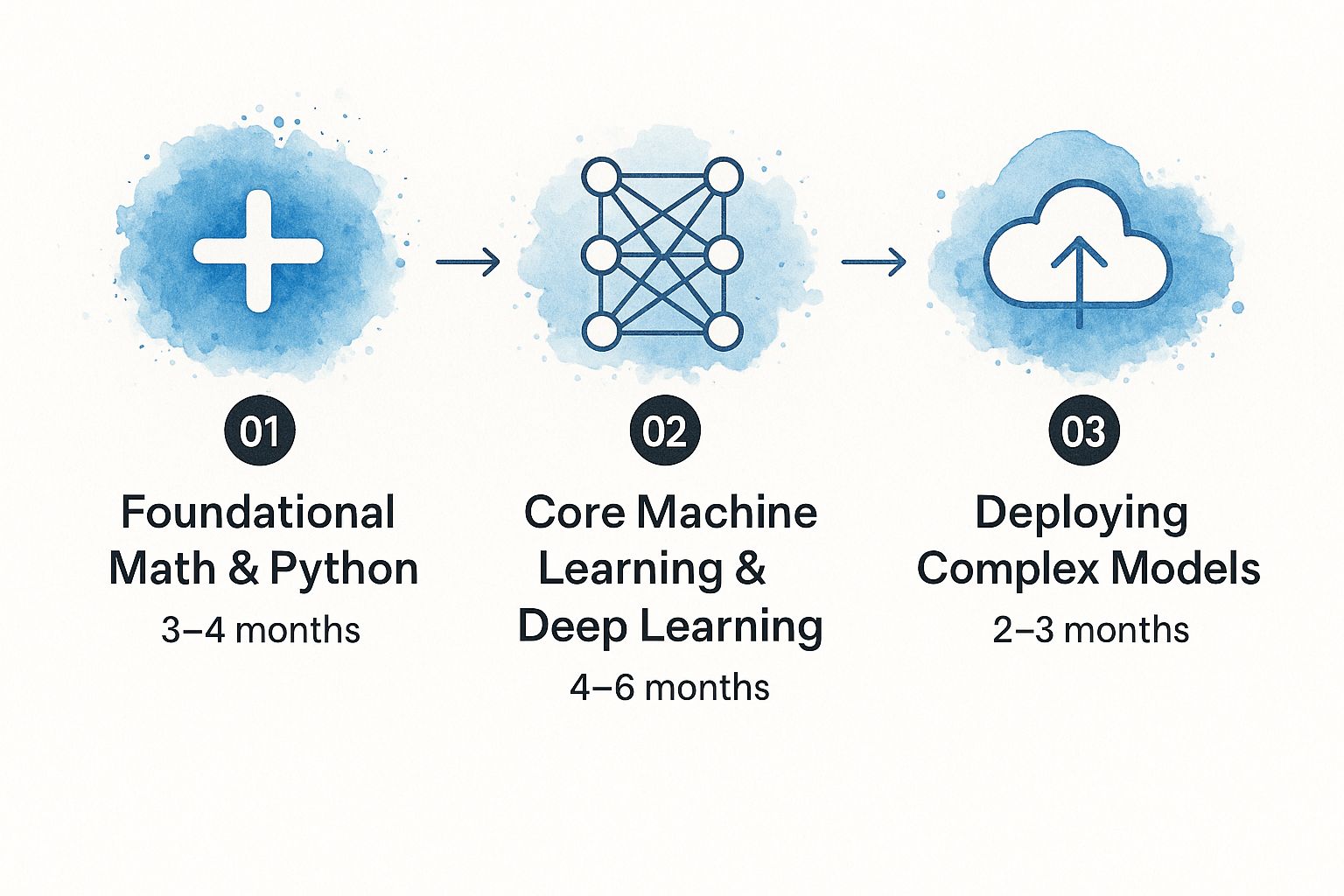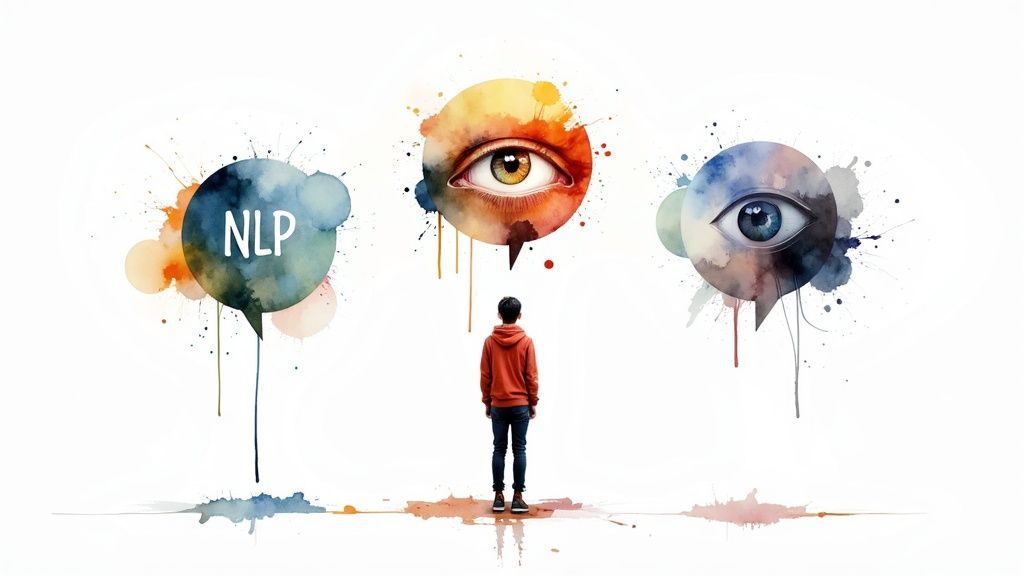Artificial Intelligence Learning Path for Your AI Career

An effective artificial intelligence learning path usually takes somewhere between 9–13 months to complete. It’s a journey I’ve seen countless people take, and the successful ones always follow a similar structure.
You start by building a strong foundation in math and Python. From there, you move into the core concepts of machine learning and deep learning. The final phase is where the real fun begins: specializing in a specific area and learning to deploy complex, real-world models. This step-by-step approach is crucial—it makes sure you truly understand the theory before you start trying to build with it.
Charting Your Course in AI Development
Jumping into artificial intelligence can feel like trying to drink from a firehose. The sheer number of courses, tools, and specializations is enough to make anyone's head spin, and it's easy to get stuck in "analysis paralysis."
The secret isn't just to start learning; it's to follow a structured path that builds your skills in a logical order. Think of it as a roadmap. A good learning path turns a massive, intimidating goal into a series of smaller, manageable steps.
Understanding the Timeline and Commitment
First things first, let's be realistic about the commitment. This isn't something you can master over a weekend. It's a serious undertaking that requires consistent effort to build a deep, valuable skill set. The journey is best broken down into clear stages, each with its own focus and timeline.
This infographic gives you a great visual overview of what that journey looks like, breaking it down into three main stages. It's a high-level look at the entire process, from total beginner to capable practitioner.

As you can see, consistent effort over about a year can get you to a place where you're ready to take on some genuinely complex challenges.
To give you a clearer idea, here's a quick breakdown of the path:
AI Learning Path at a Glance
This table lays out the core stages, the essential skills you'll pick up in each, and a realistic timeline for getting comfortable with the material.
| Stage | Key Skills | Estimated Timeline |
|---|---|---|
| Foundation Building | Python, Linear Algebra, Calculus, Probability, Statistics | 3–4 months |
| Core AI & ML Concepts | Supervised & Unsupervised Learning, Neural Networks, Deep Learning | 4–6 months |
| Specialization | NLP, Computer Vision, Reinforcement Learning, Model Deployment | 2–3 months |
| Hands-On Projects | Building and deploying your own AI models from scratch | Ongoing |
This structure is a proven way to progress without getting overwhelmed. It ensures you have the fundamentals locked down before moving on to more advanced topics.
Why a Structured Path Matters
Without a plan, it's easy to fall into the trap of jumping between random tutorials. You might build a cool-looking project, but you won't understand the "why" behind it. This creates major gaps in your knowledge that will eventually hold you back.
A structured learning path ensures you master the fundamentals first. You wouldn't build a house on a weak foundation, and the same logic applies to building expertise in a field as complex and rewarding as artificial intelligence.
This methodical approach is more important than ever. The demand for skilled AI professionals is exploding—the global AI market was valued at around USD 638.23 billion in 2025 and is projected to skyrocket to over USD 3.6 trillion by 2034. That kind of growth means huge opportunities for people with the right skills.
As you dive in, keeping up with industry trends is key. I'd recommend following resources like Parakeet AI's blog to stay on top of the latest developments and get practical insights.
Building a Strong Foundational Knowledge

Every great structure starts with a solid foundation. The same goes for building a career in artificial intelligence. Before you can jump into building complex neural networks or fine-tuning the latest large language models, you have to get the fundamentals right.
Trying to skip this part is like trying to write a novel without understanding grammar. You might get some words on the page, but they won't tell a compelling story. This first phase is all about two critical pillars: mathematics and Python programming. Don't worry, the goal isn't to turn you into a theoretical mathematician, but to give you a strong, intuitive grasp of the concepts you'll use every single day.
Why the Math Really Matters
It’s tempting to grab a library and train a model with just a few lines of code. It feels like magic. But when that model underperforms or you need to build something custom, you’ll find yourself completely stuck if you don’t understand what's happening under the hood.
That's where the math comes in. We’re not talking about abstract proofs here; we're focused on the practical application of a few key fields.
- Linear Algebra: This is the language of data in AI. Everything from images to text gets turned into vectors and matrices. Concepts like matrix multiplication are fundamental to understanding how models like Google Gemini actually process information.
- Calculus: At its heart, training an AI model is just a big optimization problem. Calculus—specifically derivatives and gradients—is what powers the whole process through techniques like gradient descent. It’s how a model “learns” by making tiny adjustments to reduce its errors.
- Probability and Statistics: AI is all about making smart predictions in the face of uncertainty. You'll rely on concepts like probability distributions and statistical significance to evaluate how well your model is performing and, just as importantly, to understand its limitations.
Think of it this way: linear algebra provides the structure for your data, calculus gives you the tools to improve your model, and statistics lets you measure how well it's all working.
Without a solid mathematical intuition, you’re just a user of AI tools. With it, you become a creator and a problem-solver, capable of building and debugging complex systems from the ground up.
Mastering Python and Its Core Libraries
While you could technically use other languages, Python has become the undisputed king of AI development. Its straightforward syntax and massive ecosystem of specialized libraries make it the most practical choice for both research and real-world applications.
But just "knowing" Python isn't enough. You need to become fluent in the core libraries that form the AI developer's toolkit.
Here are the non-negotiables you need to master first:
- NumPy: This is the absolute cornerstone for numerical computing in Python. It gives you powerful array objects and a whole suite of functions for doing math on them incredibly fast. You'll use it constantly to handle all those vectors and matrices we just talked about.
- Pandas: If NumPy is for numbers, Pandas is for data in tables. It offers brilliant data structures and tools for cleaning, transforming, and exploring datasets before you even think about feeding them into a model. It's an indispensable part of the process.
- Matplotlib & Seaborn: A model's performance metrics only tell part of the story. These two libraries are your go-to tools for data visualization, letting you create plots and charts to explore your data and present your results in a way that people can actually understand.
Getting these skills dialed in is more important than ever. By 2025, the industry is projected to need around 97 million people to support the global AI ecosystem. Professionals with this strong foundation will be perfectly positioned to step into those roles.
By focusing your initial energy on this blend of math and Python, you're not just learning to code. You're building a durable foundation that will support your entire AI journey and set you up for success for years to come.
Mastering Core Machine Learning and Deep Learning

Alright, you've put in the work on the math and programming fundamentals. Now it's time to step into the engine room—the place where you'll finally start working with the algorithms and models that power modern AI.
This is where the real fun begins. You're moving past preparation and into the world of making predictions and uncovering hidden patterns in data. The key is to be methodical. You need to build a strong intuition for traditional machine learning before you even think about tackling the deep end of deep learning.
Exploring Supervised and Unsupervised Learning
Machine learning is broadly split into two camps, and understanding the difference is your first big hurdle. It all comes down to the kind of data you have and what you’re trying to accomplish.
Supervised learning is what most people picture when they think of AI. You have a dataset where the answers are already included (these are your "labels"), and you train a model to predict those answers for new data. Think of it like a set of flashcards for a toddler—you show them a picture of a dog with the word "dog" written underneath.
This breaks down into two main jobs:
- Classification: Predicting a specific category. A classic example is an email spam filter that decides if a message is "spam" or "not spam."
- Regression: Predicting a continuous number. Think of a real estate app trying to predict a house's price based on its square footage, location, and number of bedrooms.
Unsupervised learning, on the other hand, is for when you have data with no labels. You aren’t trying to predict a known answer. Instead, your goal is to let the algorithm find interesting structures on its own. A marketing team might use an unsupervised technique like clustering to automatically group customers into segments based on their buying habits, without knowing what those groups are ahead of time.
Want to make this real? Don't just read about it. Build a simple regression model to predict something, then tackle a classic classification problem with a dataset like the Iris flower set. That hands-on struggle is where the theory actually clicks.
Demystifying Deep Learning and Neural Networks
Once you feel comfortable with the standard machine learning models, you're ready to explore deep learning. This is really just a subfield of machine learning that uses something called artificial neural networks—models that are loosely inspired by the structure of the human brain.
These networks are made of layers of interconnected "neurons" that process information. The "deep" part simply means the network has a lot of layers, sometimes hundreds or even thousands. This depth is what allows them to learn incredibly complex patterns, which is why they're so good at tasks that once seemed impossible for computers, like understanding images or generating human-like text.
Don't get overwhelmed. Start small and build up:
- First, understand a single neuron (also called a perceptron). See how it takes inputs, applies weights, and uses an activation function.
- Next, connect a few of these neurons into layers to build a simple neural network. Try coding one from scratch to really get a feel for how data flows through it (forward propagation) and how it learns from mistakes (backward propagation).
- Only then should you start exploring the more complex, specialized architectures.
Comparing Key Machine Learning Models
As you learn more algorithms, it’s easy to get them mixed up. It helps to have a mental map of what model works best for what kind of problem.
Here’s a quick-glance table to help you keep things straight:
| Model Type | Primary Use Case | Example Algorithms |
|---|---|---|
| Supervised Learning | Predicting outcomes from labeled data | Linear Regression, Logistic Regression, Support Vector Machines (SVM), Decision Trees |
| Unsupervised Learning | Finding hidden patterns in unlabeled data | K-Means Clustering, Principal Component Analysis (PCA), Hierarchical Clustering |
| Deep Learning | Complex pattern recognition with large datasets | Convolutional Neural Networks (CNNs), Recurrent Neural Networks (RNNs) |
This table is a great starting point, but remember, the real understanding comes from actually using these algorithms on real data and seeing how they behave.
Specialized Architectures for Real-World Problems
Within deep learning, you’ll quickly run into a couple of specialized network types that have become the go-to solutions for specific problems. You don't need to master them all at once, but you absolutely need to know these two.
- Convolutional Neural Networks (CNNs): These are the undisputed champions of image recognition. CNNs are brilliant because they’re designed to automatically learn features from images in a hierarchical way. The first layer might learn to see simple edges, the next layer learns to combine those edges into corners and shapes, and deeper layers might recognize things like eyes or noses. This is the magic behind facial recognition and self-driving car vision systems.
- Recurrent Neural Networks (RNNs): These are built for sequential data—anything where the order of things matters, like text, speech, or stock prices. RNNs have a kind of "memory" that lets them use information from earlier in a sequence to inform their understanding of what’s happening now. This makes them perfect for language translation, chatbots, and predicting time-series data.
A great way to solidify your skills is to build two cornerstone projects: a simple image classifier using a CNN and a sentiment analyzer for text using an RNN. These projects force you to apply everything you’ve learned and look fantastic in a portfolio.
Finding Your Niche and Building Practical Skills

Knowing the broad strokes of machine learning is a great start, but the real magic—and the best career opportunities—happens when you specialize. This is where your artificial intelligence learning path gets really interesting. You stop being just a student of AI and start becoming a practitioner who can walk into a company and solve tangible problems.
Picking a niche isn't about chasing the latest trend. It’s about finding that sweet spot where your genuine interests meet real market demand. Are you fascinated by how we can teach computers to understand and generate language? Or does the idea of giving machines the power of sight grab you? Now’s the time to focus your energy where it’ll make the biggest splash.
Choosing Your AI Specialization
While the world of AI is vast, a few key specializations are driving the industry forward right now. Each one tackles a different kind of problem and requires a unique mindset. Let's break down the big three.
- Natural Language Processing (NLP): This is where language and AI collide. NLP pros build everything from the chatbots we interact with daily to sophisticated sentiment analysis tools and language translation services. If you have a knack for linguistics and enjoy wrestling with text data, this is an incredibly rewarding path.
- Computer Vision: This field is all about teaching computers to see and make sense of the visual world, just like we do. Think self-driving cars navigating busy streets, AI analyzing medical scans, or facial recognition systems. It’s the perfect fit if you’re a visual thinker.
- Generative AI: This is the force behind the models that create brand-new content—text, images, music, you name it. It's an explosive field that demands a solid grasp of complex architectures like transformers and diffusion models. A huge part of the job is crafting precise instructions, and you can get a head start by mastering AI prompt engineering tips, tricks, and resources.
Diving deep into one of these areas makes you far more valuable than someone who only has a surface-level knowledge of everything.
Shifting from Theory to Real-World Application
So far, you’ve probably spent a lot of time learning algorithms and maybe even building a few models from scratch. That's a crucial part of your education, but it’s not how most AI gets built in the real world. The modern approach is all about speed and practicality.
Forget spending months building a massive model from the ground up. Today’s practitioners are all about using powerful, pre-trained models and platforms. This is a major pivot in your learning journey. The goal shifts from simply knowing how a model works to knowing how to adapt it to solve a specific business problem quickly and efficiently.
The most valuable skill in today's AI landscape isn't building a neural network from scratch—it's knowing how to take a powerful, pre-existing model and fine-tune it to perform a new task with high accuracy and minimal resources.
This pivot is exactly why AI adoption has exploded. The barrier to entry has been obliterated by hyperscalers like Microsoft Azure OpenAI, AWS Bedrock, and Google Vertex AI. Companies no longer need to build huge, in-house AI teams from scratch. This has opened the doors for organizations of all sizes, including small and medium-sized businesses, to jump on the AI train.
Mastering Essential Platforms and Tools
To be a valuable practitioner, you need to speak the language and use the tools of the trade. That means getting your hands dirty with the platforms that companies rely on every day. Your focus should shift to these key areas.
Here are the modern platforms you need on your radar:
- Hugging Face: This platform is the undisputed center of the AI universe. It's a massive hub of thousands of pre-trained models, datasets, and tools, mostly for NLP but expanding into other areas. Learning to use its
transformerslibrary to download and fine-tune a model isn't just a good skill—it's essential. - Cloud AI Platforms: Every major cloud provider has a powerful suite of AI services. You don’t need to master them all, but deep familiarity with at least one is a must.
- Google Vertex AI
- Microsoft Azure OpenAI Service
- Amazon SageMaker
- Google Vertex AI
- Microsoft Azure OpenAI Service
- Amazon SageMaker
These platforms handle all the messy infrastructure, letting you focus on what really matters: the model. Experience with any of these will make your resume stand out.
Building a Portfolio That Solves Problems
Your final goal in this stage is to create a portfolio of projects that screams "I can solve real problems." Move beyond the classic textbook examples everyone else is doing. Find a unique problem that you actually care about and use these modern tools to build a solution.
Let’s say you picked NLP. Don't just build yet another movie review sentiment analyzer. Why not try something like this?
- Fine-tune a language model to automatically categorize customer support tickets for a niche industry.
- Build a tool that summarizes dense technical articles from a field you're passionate about.
- Create a specialized chatbot that can answer questions from a custom knowledge base, like a video game wiki or a company's internal documentation.
Projects like these show so much more than just technical chops. They show creativity, problem-solving skills, and the ability to deliver a finished, useful product. This is what truly closes the gap between academic knowledge and job-ready expertise, turning your artificial intelligence learning path into a direct route to a successful career.
Growing Your Career and Staying Relevant in AI
Landing your first job in artificial intelligence isn’t the finish line; it’s just the start of a much more dynamic phase of your learning journey. The skills that got you in the door are valuable, but the AI field moves at a breakneck speed. Continuous learning isn't just a nice-to-have—it's a core part of the job itself.
To stay relevant, you have to build a sustainable practice of skill development. It's about creating your own system to absorb what's new, give back to the community, and consistently prove your value in a landscape that practically reinvents itself every few months.
Cultivating Continuous Learning Habits
To avoid falling behind, you need a strategy for staying current without getting completely overwhelmed. The firehose of new research, models, and tools will never stop, so your goal is to get good at filtering and absorbing what actually matters.
My personal strategy boils down to a few key habits:
- Efficiently Scan Research: I block off a little time each week to browse new papers on arXiv. I don't read every paper cover to cover. Instead, I scan the abstract, introduction, and conclusion to get the main idea and its potential impact.
- Follow Key Voices: Curate a list of leading researchers, engineers, and AI communicators on platforms like X (formerly Twitter) and LinkedIn. Their discussions are often the best high-level summary of what’s happening in the industry.
- Experiment with New Tools: When a new model or library starts generating buzz, I make a point to try it out, even with a tiny, simple project. Nothing beats hands-on experience for understanding a tool's true capabilities and limitations.
This approach turns staying current from a chore into a manageable, even engaging, part of your weekly routine.
Proving Your Value Through Contribution
Once you have a job, your portfolio of personal projects starts to matter less than your real-world contributions. The best way to grow your career is to make a tangible impact, and one of the most effective ways to do that is by getting involved in open-source.
Finding a meaningful project on GitHub can feel intimidating, but it’s a powerful way to learn from seasoned developers and get your name on code that people actually use. Look for well-maintained projects with clear contribution guidelines and start small. Fixing a bug, improving documentation, or adding a small feature are all fantastic ways to get your foot in the door.
This not only deepens your technical skills but also expands your professional network in a genuine, collaborative way.
In AI, your career momentum is directly tied to your learning velocity. The moment you stop adapting is the moment you start becoming obsolete. Sustainable growth requires a commitment to lifelong curiosity and hands-on application.
Navigating Job Interviews and Career Progression
As you advance, the nature of job interviews changes. Early on, they focus heavily on theoretical knowledge and whiteboard coding challenges. Later, the conversation shifts to your ability to solve complex business problems and articulate the impact of your work.
When you're preparing for that next role, structure your resume and talking points around results. Instead of just saying you "built a model," explain the problem you solved, the approach you took, and the measurable outcome you achieved. Did you increase efficiency by 15%? Reduce error rates by 20%? Those are the metrics that prove your value.
Technical challenges will also become more practical, often involving a take-home project or a system design discussion. These are meant to test your real-world problem-solving skills, not just your ability to recite algorithms. For instance, you might be asked to architect a system that uses AI with real-time data, which would require understanding how to connect ChatGPT to the internet for seamless usage. This shows you can think beyond the model and consider the entire application ecosystem.
Ultimately, a long and rewarding career in AI is built on a foundation of continuous, adaptive learning. By developing habits to stay current, contributing to the community, and proving your impact, you transform your AI learning path from a one-time effort into a lifelong journey of growth.
Common Questions About the AI Learning Path
Jumping into artificial intelligence always kicks up a lot of questions. It's a huge field with some seriously complex ideas, so it’s completely natural to wonder if you're heading in the right direction. Let's tackle some of the most common concerns I hear from people who are just getting their feet wet.
How Much Math Do I Really Need for AI?
This is, without a doubt, the question I get asked the most. The short answer is: you need a practical, intuitive grasp of it, not a PhD in theoretical mathematics. A solid handle on Linear Algebra, Calculus, and Probability is absolutely non-negotiable.
Think of it like this: these branches of math are the language that machine learning models speak. You can't get fluent without understanding the grammar.
- Linear Algebra is how you'll work with data, representing everything as vectors and matrices.
- Calculus, especially derivatives, is the engine that drives how models actually learn through optimization.
- Probability is what allows you to understand and measure the uncertainty baked into your model's predictions.
Your focus should be on application, not getting lost in abstract proofs. The goal is to know why a concept is useful for building something, not just how to solve an equation on a whiteboard.
Can I Learn AI Without a Computer Science Degree?
Absolutely. A formal degree gives you a great, structured foundation, but it’s far from the only way in. Honestly, some of the most brilliant AI engineers I've worked with are self-taught or came from other quantitative fields like physics, economics, or statistics.
These days, the internet is packed with high-quality courses, open-source code, and supportive communities that make learning on your own more doable than ever. At the end of the day, what hiring managers really want to see is what you can build. A strong portfolio of well-documented projects will always speak louder than a specific degree on your resume.
The real keys are discipline and a relentless focus on building. A degree proves you can follow a curriculum; a portfolio proves you can create real-world value. Both are great, but only one is completely in your control right now.
Which Programming Language Is Best for AI?
Just start with Python. This isn't even a debate anymore. It has cemented itself as the standard for AI and data science, and for a few very good reasons.
First off, the syntax is clean and relatively easy to pick up, which means you can start building faster. But more importantly, Python has a massive ecosystem of powerful libraries that do all the heavy lifting for you. Tools like TensorFlow, PyTorch, NumPy, and Pandas are the bedrock of the field—you’ll be using them every single day. While other languages like R or C++ have their roles in certain niches, Python is the most direct and versatile path into the world of AI.
If you have more specific questions on the technical side, you might find some useful information by understanding AI features.
How Long Until I Am Job-Ready?
This is the classic "it depends" question, but I can give you a realistic window. A dedicated person who puts in consistent work can get a solid grasp of the fundamentals and build a respectable portfolio in about 6 to 12 months.
Getting to an advanced or senior level, though? That takes years of continuous, hands-on work. The biggest factor influencing your timeline is how you learn. If you just passively watch video tutorials, it’s going to take forever. The secret to speeding things up is simple: build things. Consistently working on projects is the fastest way to forge theoretical knowledge into job-ready skills.
At PromptDen, we're building a community where you can find the high-quality prompts and workflows needed to accelerate your projects. Whether you're fine-tuning a language model or creating stunning visuals, explore our platform to discover, share, and master the art of prompt engineering. Visit us at https://promptden.com to get started.